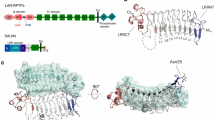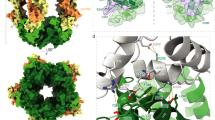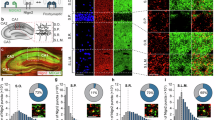Abstract
N-methyl-D-aspartate receptors (NMDAR) mediate long-lasting changes in synapse strength via downstream signaling pathways. We report proteomic characterization with mass spectrometry and immunoblotting of NMDAR multiprotein complexes (NRC) isolated from mouse brain. The NRC comprised 77 proteins organized into receptor, adaptor, signaling, cytoskeletal and novel proteins, of which 30 are implicated from binding studies and another 19 participate in NMDAR signaling. NMDAR and metabotropic glutamate receptor subtypes were linked to cadherins and L1 cell-adhesion molecules in complexes lacking AMPA receptors. These neurotransmitter–adhesion receptor complexes were bound to kinases, phosphatases, GTPase-activating proteins and Ras with effectors including MAPK pathway components. Several proteins were encoded by activity-dependent genes. Genetic or pharmacological interference with 15 NRC proteins impairs learning and with 22 proteins alters synaptic plasticity in rodents. Mutations in three human genes (NF1, Rsk-2, L1) are associated with learning impairments, indicating the NRC also participates in human cognition.
This is a preview of subscription content, access via your institution
Access options
Subscribe to this journal
Receive 12 print issues and online access
$209.00 per year
only $17.42 per issue
Buy this article
- Purchase on SpringerLink
- Instant access to full article PDF
Prices may be subject to local taxes which are calculated during checkout


Similar content being viewed by others
References
Bliss, T. V. & Collingridge, G. L. A synaptic model of memory: long-term potentiation in the hippocampus. Nature 361 , 31–39 (1993).
Bear, M. F. & Malenka, R. C. Synaptic plasticity: LTP and LTD. Curr. Opin. Neurobiol. 4, 389– 399 (1994).
Heresco-Levy, U. & Javitt, D. C. The role of N-methyl-D-aspartate (NMDA) receptor-mediated neurotransmission in the pathophysiology and therapeutics of psychiatric syndromes. Eur. Neuropsychopharmacol. 8, 141–152 ( 1998).
Hollmann, M. & Heinemann, S. Cloned glutamate receptors. Annu. Rev. Neurosci. 17, 31–108 (1994).
Sanes, J. R. & Lichtman, J. W. Can molecules explain long-term potentiation? Nat. Neurosci. 2, 597– 604 (1999).
Pawson, T. & Scott, J. D. Signaling through scaffold, anchoring, and adaptor proteins. Science 278, 2075– 2080 (1997).
Kim, J. H. & Huganir, R. L. Organization and regulation of proteins at synapses. Curr. Opin. Cell Biol. 11, 248–254 (1999).
Hsueh, Y. P. & Sheng, M. Anchoring of glutamate receptors at the synapse. Prog. Brain Res. 116, 123– 131 (1998).
Kornau, H. C., Seeburg, P. H. & Kennedy, M. B. Interaction of ion channels and receptors with PDZ domain proteins. Curr. Opin. Neurobiol. 3, 368–373 (1997).
Migaud, M. et al. Enhanced long-term potentiation and impaired learning in mice with mutant postsynaptic density-95 protein. Nature 396, 433–439 (1998).
Mendelsohn, A. R. & Brent, R. Protein interaction methods—toward an endgame. Science 284, 1948–1950 (1999).
Neubauer, G. et al. Mass spectrometry and EST-database searching allows characterization of the multi-protein spliceosome complex. Nat. Genet. 20, 46–50 (1998).
Hisatsune, C., Umemori, H., Mishina, M. & Yamamoto, T. Phosphorylation-dependent interaction of the N-methyl-D-aspartate receptor epsilon 2 subunit with phosphatidylinositol 3-kinase. Genes Cells 4, 657– 666 (1999).
Craven, S. E., El-Husseini, A. E. & Bredt, D. S. Synaptic targeting of the postsynaptic density protein PSD-95 mediated by lipid and protein motifs. Neuron 22, 497–509 (1999).
Blackstock, W. P. & Weir, M. P. Proteomics: quantitative and physical mapping of cellular proteins. Trends Biotechnol. 17, 121–127 (1999).
O'Brien, R. J., Lau, L. F. & Huganir, R. L. Molecular mechanisms of glutamate receptor clustering at excitatory synapses. Curr. Opin. Neurobiol. 8, 364–369 (1998).
Garcia, E. P. et al. SAP90 binds and clusters kainate receptors causing incomplete desensitization. Neuron 21, 727– 739 (1998).
Naisbitt, S. et al. Shank, a novel family of postsynaptic density proteins that binds to the NMDA receptor/PSD-95/GKAP complex and cortactin. Neuron 23, 569–582 ( 1999).
Tu, J. C. et al. Coupling of mGluR/Homer and PSD-95 complexes by the Shank family of postsynaptic density proteins. Neuron 23, 583–592 (1999).
Leonard, A. S., Lim, I. A., Hemsworth, D. E., Horne, M. C. & Hell, J. W. Calcium/calmodulin-dependent protein kinase II is associated with the N-methyl-D-aspartate receptor. Proc. Natl. Acad. Sci. USA 96, 3239– 3244 (1999).
Westphal, R. S. et al. Regulation of NMDA receptors by an associated phosphatase-kinase signaling complex. Science 285, 93– 96 (1999).
Wang, Y. T. & Salter, M. W. Regulation of NMDA receptors by tyrosine kinases and phosphatases. Nature 369, 233–235 (1994).
O'Dell, T. J., Kandel, E. R. & Grant, S. G. Long-term potentiation in the hippocampus is blocked by tyrosine kinase inhibitors. Nature 353, 558–560 (1991).
Lin, S. Y. et al. Brain-derived neurotrophic factor enhances association of protein tyrosine phosphatase PTP1D with the NMDA receptor subunit NR2B in the cortical postsynaptic density. Mol. Brain Res. 70, 18–25 (1999).
Brambilla, R. et al. A role for the Ras signalling pathway in synaptic transmission and long-term memory. Nature 390, 281– 286 (1997).
Silva, A. J. et al. A mouse model for the learning and memory deficits associated with neurofibromatosis type I. Nat. Genet. 15, 281–284 (1997).
Gille, H. & Downward, J. Multiple ras effector pathways contribute to G(1) cell cycle progression. J. Biol. Chem. 274, 22033–22040 (1999).
Schaeffer, H. J. & Weber, M. J. Mitogen-activated protein kinases: specific messages from ubiquitous messengers. Mol. Cell. Biol. 19, 2435–2444 (1999).
Mitsuuchi, Y. et al. Identification of a chromosome 3p14.3-21.1 gene, APPL, encoding an adaptor molecule that interacts with the oncoprotein-serine/threonine kinase AKT2. Oncogene 18, 4891– 4898 (1999).
Impey, S., Obrietan, K. & Storm, D. R. Making new connections: role of ERK/MAP kinase signaling in neuronal plasticity. Neuron 23, 11– 14 (1999).
Link, W. et al. Somatodendritic expression of an immediate early gene is regulated by synaptic activity. Proc. Natl. Acad. Sci. USA 92 , 5734–5738 (1995).
Lyford, G. L. et al. Arc, a growth factor and activity-regulated gene, encodes a novel cytoskeleton-associated protein that is enriched in neuronal dendrites . Neuron 14, 433–445 (1995).
Lin, L. L. et al. cPLA2 is phosphorylated and activated by MAP kinase. Cell 72, 269–278 ( 1993).
Bonventre, J. V. et al. Reduced fertility and postischaemic brain injury in mice deficient in cytosolic phospholipase A2. Nature 390, 622–625 (1997).
Murase, S. & Schuman, E. M. The role of cell adhesion molecules in synaptic plasticity and memory. Curr. Opin. Cell Biol. 11, 549–553 (1999).
Rosenmund, C. & Westbrook, G. L. Calcium-induced actin depolymerization reduces NMDA channel activity. Neuron 10, 805–814 (1993).
Kim, C. H. & Lisman, J. E. A role of actin filament in synaptic transmission and long-term potentiation. J. Neurosci. 19, 4314–4324 (1999).
Allison, D. W., Gelfand, V. I., Spector, I. & Craig, A. M. Role of actin in anchoring postsynaptic receptors in cultured hippocampal neurons: differential attachment of NMDA versus AMPA receptors. J. Neurosci. 18, 2423–2436 (1998).
Fischer, M., Kaech, S., Knutti, D. & Matus, A. Rapid actin-based plasticity in dendritic spines. Neuron 20, 847–854 (1998).
Wechsler, A. & Teichberg, V. I. Brain spectrin binding to the NMDA receptor is regulated by phosphorylation, calcium and calmodulin. EMBO J. 17, 3931–3939 ( 1998).
Luthl, A., Laurent, J. P., Figurov, A., Muller, D. & Schachner, M. Hippocampal long-term potentiation and neural cell adhesion molecules L1 and NCAM. Nature 372, 777–779 (1994).
Tang, L., Hung, C. P. & Schuman, E. M. A role for the cadherin family of cell adhesion molecules in hippocampal long-term potentiation. Neuron 20, 1165–1175 (1998).
Sans, N., Petralia, R. S., Wang, Y. X., Blahos, J., Hell, J. W. & Wenthold, R. J. A developmental change in NMDA receptor-associated proteins at hippocampal synapses. J. Neurosci. 20, 1260–1271 (2000).
Grant, S. G. N. in Handbook of Molecular-Genetic Techniques for Brain and Behavior Research (eds. Crusio, W. E. & Gerlai, R. T.) 315– 328 (Elsevier, Amsterdam, 1999).
Ozonoff, S. Cognitive impairment in neurofibromatosis type 1. Am. J. Med. Genet. 89, 45–52 ( 1999).
Fransen, E., Van Camp, G., D'Hooge, R., Vits, L. & Willems, P. J. Genotype-phenotype correlation in L1 associated diseases. J. Med. Genet. 35, 399–404 (1998).
Merienne, K. et al. A missense mutation in RPS6KA3 (RSK2) responsible for non-specific mental retardation. Nat. Genet. 22, 13– 14 (1999).
Shevchenko, A., Wilm, M., Vorm, O. & Mann, M. Mass spectrometric sequencing of proteins silver-stained polyacrylamide gels. Anal. Chem. 68, 850–858 ( 1996).
Wilm, M. et al. Femtomole sequencing of proteins from polyacrylamide gels by nano-electrospray mass spectrometry. Nature 379, 466–469 (1996).
Link, A. J. et al. Direct analysis of protein complexes using mass spectrometry . Nat. Biotechnol. 17, 676– 682 (1999).
Acknowledgements
Antibodies were provided by those listed in Methods. We thank T.J. O'Dell and P. Brophy for comments. H.H. and S.G. were supported by the Wellcome Trust.
Author information
Authors and Affiliations
Corresponding author
Supplementary information
Rights and permissions
About this article
Cite this article
Husi, H., Ward, M., Choudhary, J. et al. Proteomic analysis of NMDA receptor–adhesion protein signaling complexes. Nat Neurosci 3, 661–669 (2000). https://doi.org/10.1038/76615
Received:
Accepted:
Published:
Issue Date:
DOI: https://doi.org/10.1038/76615
This article is cited by
-
The Roles of hnRNP Family in the Brain and Brain-Related Disorders
Molecular Neurobiology (2024)
-
Excitation–transcription coupling, neuronal gene expression and synaptic plasticity
Nature Reviews Neuroscience (2023)
-
Brain-enriched guanylate kinase-associated protein, a component of the post-synaptic density protein complexes, contributes to learning and memory
Scientific Reports (2023)
-
Chicken pituitary transcriptomic responses to acute heat stress
Molecular Biology Reports (2023)
-
Developmental disruption and restoration of brain synaptome architecture in the murine Pax6 neurodevelopmental disease model
Nature Communications (2022)




